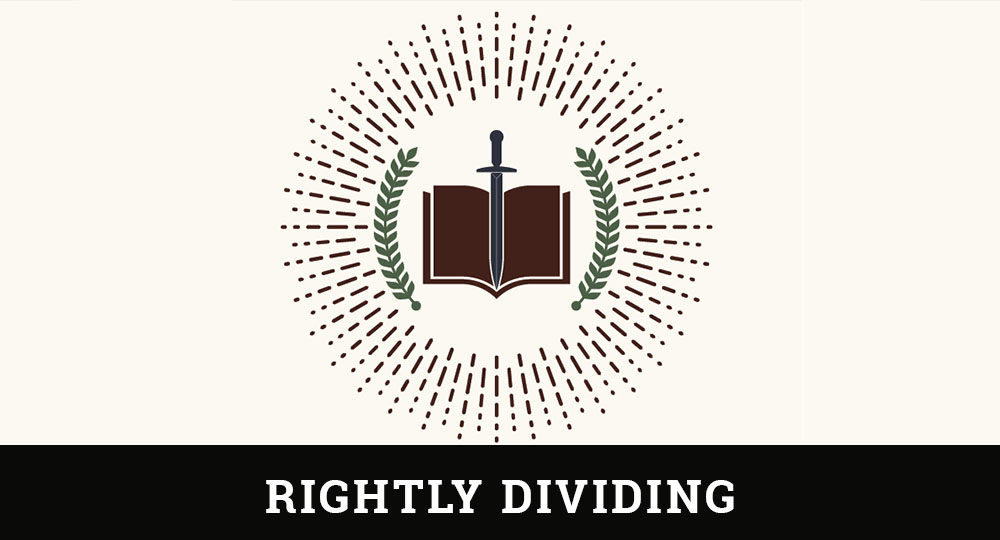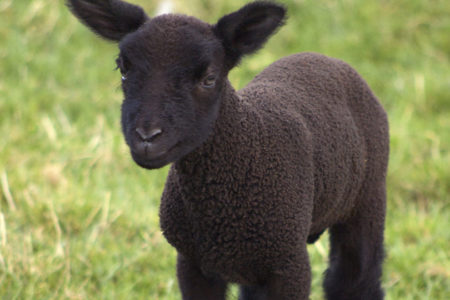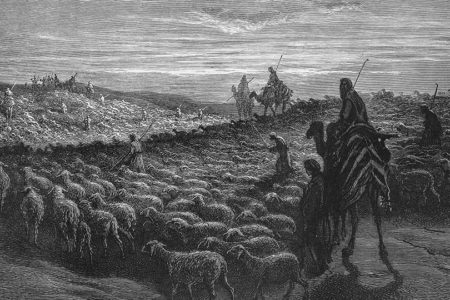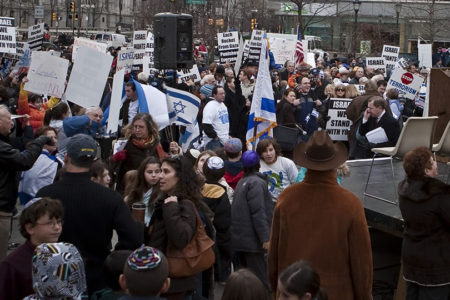The Hebrew Tabernacle Hebrews 9:1–10
Christ’s high priesthood is superior to the Levitical priesthood because it is based on a New Covenant and operates in a heavenly sanctuary. When referring to the heavenly sanctuary, the author of Hebrews did not speak of the Solomonic Temple (destroyed in 586 B.C.) or the Herodian Temple that was still standing. Instead, he went back to the Tabernacle in the wilderness, which, with its sacrifices and service, originally typified the Lord’s ministry in heaven. Since the Tabernacle was merely a shadow of the real sanctuary in heaven, Scripture takes us out of the shadows to reveal in great detail Christ’s superior ministry in the heavenly sanctuary.
This chapter and the next show that Christ’s ministry functions in a new sanctuary with a new service and is based on a once-for-all sacrifice.
Sanctuary of the Tabernacle
The chapter begins by reviewing familiar facts about the Tabernacle’s sanctuary and service under the Mosaic Covenant, reminding readers the Hebrew sanctuary was merely a copy of the heavenly one:
Then indeed, even the first covenant had ordinances of divine service and the earthly sanctuary. For a tabernacle was prepared: the first part, in which was the lampstand, the table, and the showbread, which is called the sanctuary; and behind the second veil, the part of the tabernacle which is called the Holiest of All, which had the golden censer and the ark of the covenant overlaid on all sides with gold, in which were the golden pot that had the manna, Aaron’s rod that budded, and the tablets of the covenant; and above it were the cherubim of glory overshadowing the mercy seat. Of these things we cannot now speak in detail (Heb. 9:1–5)
Assuming readers were familiar with the Tabernacle, the author did not mention the courtyard or its surrounding curtain, gate, brazen altar, or laver. He did mention four pieces of furniture used in worship: the lampstand, table of showbread, golden censer, and the Ark of the Covenant. Keep in mind the service mentioned in the first (Mosaic) Covenant was divinely established by God (v. 1) and used by the priests to intercede on behalf of the people.
The Tabernacle proper was 15 feet wide, 45 feet long, and 15 feet high. It was divided into two sections: the sanctuary, or holy place, was 15 feet wide and 30 feet long; and the Holiest of All (Holy of Holies) was 15 feet square (vv. 2–3).
The sanctuary contained three pieces of furniture: the lampstand, table of showbread, and golden censer. The lampstand (v. 2, cf. Ex. 25:31–40) stood on the left (south) and was hand-hammered (not made from a mold) from a single talent of pure gold weighing 90 pounds (Ex. 37:17, 24). It had a center stem with three branches on each side, making it seven-pronged.
Light from the huge lampstand filled every corner of the sanctuary with a warm, shimmering brilliance, providing illumination for the priest as he ministered. It was the priest’s duty to care for the lampstand. He kept the lamps burning perpetually by filling them daily with pure olive oil (27:20–21). He trimmed each lamp every evening and morning (30:7–8) using pure gold tongs and snuff dishes to collect the used wicks (25:38).
The table for the showbread was made of acacia wood covered with gold (Heb. 9:2). A gold rim encircled its top. Gold rings were placed at each corner, and gold-covered acacia-wood staves were placed through the rings to carry it. The table stood on the right (north) and was three feet long, one and a half feet wide, and two and three-tenths feet high (Ex. 25:23–28). Twelve cakes of unleavened bread containing about six pounds of flour were arranged weekly on the table in two rows of six each in an elaborate service. The bread represented the 12 tribes of Israel. It was called showbread (literally, “bread of the face,” or “bread of presence”) because it was set before the face, or presence, of Jehovah (who dwelt in the Holy of Holies) as a meal offering from the children of Israel (Lev. 24:8). God gazed with delight on the pure bread offering that sat continually before His face.
The golden altar of incense was 36 inches high and 18 inches square. It was made of acacia wood covered with gold. It had a horn at each corner pointing outward, and a gold rim encircling the top, with gold rings at each corner. Gold-covered acacia-wood staves went through the rings to transport it (Ex. 30:1–4). The altar of incense was actually in the sanctuary in front of the veil (v. 6; 40:5), not in the Holy of Holies. But the high priest filled it with burning incense and took it into the Holy of Holies on the Day of Atonement (Lev. 16:12–13).
The Holy of Holies, which had a huge “second veil” (Heb. 9:3) shielding its entrance, contained only the Ark of the Covenant. The Ark was a rectangular box, three feet nine inches long and two feet three inches wide and high, made of acacia wood overlaid with gold inside and out. It had a gold rim encircling its top, gold rings on the four corners, and staves of gold-covered acacia wood to carry it. The lid, called the mercy seat, was of pure gold. Two cherubim of gold stood on top of the Ark, facing each other. They looked down on the mercy seat, their wings touching, as they stretched out over its top (Ex. 25:10–22).
Hebrews 9:4 states the Ark contained three objects: “the golden pot that had the manna, Aaron’s rod that budded, and the tables of the covenant.” It has been suggested that a contradiction exists in Scripture because 1 Kings 8:9 says only the tablets of the Law were in the Ark. But there is no contradiction. Hebrews 9:4 describes the Ark’s original contents, while 1 Kings 8:9 records the contents at the time of Solomon’s Temple.
After describing the Tabernacle and its furnishings, the author made no mention of the Tabernacle’s relationship to or fulfillment in Christ because it was merely a type and shadow of Christ’s earthly ministry, which was already completed. Later in the chapter he focused on Christ’s ministry in the heavenly sanctuary.
Service of the Tabernacle
Hebrews 9:6–7 briefly describes the service of the sanctuary and Holy of Holies. Priests ministered daily in “the first part [sanctuary] of the tabernacle” (v. 6). Each evening and morning they trimmed and lit the golden lamp-stand that burned perpetually. They replaced and partook of the show-bread every Sabbath, then ate the old bread; and they burned sweet incense evening and morning on the golden altar of incense, the ascending fragrance of which symbolized the worship and prayers of Israel to God.
The high priest alone entered the second room (Holy of Holies) only “once a year, not without blood” (v. 7). He did so on the Day of Atonement (Yom Kippur), the 10th day of Tishri (September/October). Divested of his royal, priestly garments and clothed only in white linen (Lev. 16:4), he parted the huge veil and entered the Holy of Holies to offer blood “for himself and for the people’s sins committed in ignorance” (Heb. 9:7). It was necessary that he enter to offer blood, for “without shedding of blood there is no remission” of sin (v. 22; cf. Lev. 17:11). This was either a day of judgment or life for the people of Israel. If the Lord did not accept the blood atonement, the high priest would die in the Holy of Holies; and the people would not have their sins covered. If the high priest emerged alive, God had accepted the blood atonement for Israel’s sin.
Spiritual Significance of the Tabernacle
The Tabernacle, along with its regulations, had been given by direct revelation from God. But it was designed only to be “symbolic [literally, “a parable”] for the present time” (Heb. 9:9). A parable is an earthly story used to illustrate or teach a spiritual truth. The ordered service of the Tabernacle, mediated through the Levitical priesthood, was used as an object lesson in which the Holy Spirit (v. 8) taught the true realities of God to Israel. There are three lessons here:
- Way to God. The Holy Spirit taught, “The way into the Holiest of All was not yet made manifest while the first tabernacle was still standing” (v. 8). In other words, the way into the Holy of Holies was not disclosed until the inner veil between the two rooms was torn at Christ’s crucifixion. After that event, everyone had access through Christ into God’s presence. Opening the Holy of Holies was an indication to the Levitical priests that their ministry had been dissolved.
- Worship of God. The Spirit taught that the Israelites could not be made perfect (brought into a right relationship with God) through the gifts and sacrifices they offered (v. 9). The sacrifices were powerless to remove sin. Thus worshipers experienced no peace but continually had guilty consciences (v. 9).
- Works of the priests’ service. The Spirit also taught that such ordinances as “foods and drinks” and “various washings” were “fleshly” (v. 10). The word fleshly does not mean “sinful.” Rather, it indicates these sacrificial, ceremonial regulations lacked sufficient value because they removed only external defilement and depended solely on the strength of the flesh. In other words, the Tabernacle and its Levitical sacrificial system were temporary and utterly incapable of bringing the Israelites into a right standing before God.
They were provisionally imposed on Israel “until the time of reformation” (literally, “setting things right, a complete rectification”; v. 10). They could not set things right or restore mankind to a right relationship with God. The Tabernacle and its service were a temporary shadow, external figure, and parable used to represent spiritual truths and point people to a new and better program that God would establish through the ministry of Christ.
A new order was inaugurated when Christ offered Himself as the perfect and final Sacrifice for sin. He fulfilled all the types and shadows mentioned here and made it possible for God to expiate sin. The day of rectification came when the Temple veil was torn in half, opening the way for people to go directly to God through the blood of Christ for the forgiveness of sin. From that day forward, the Levitical system, along with its blood sacrifices, was set aside.







What are the chances of the people, even the priests, of figuring out what all these symbols meant?